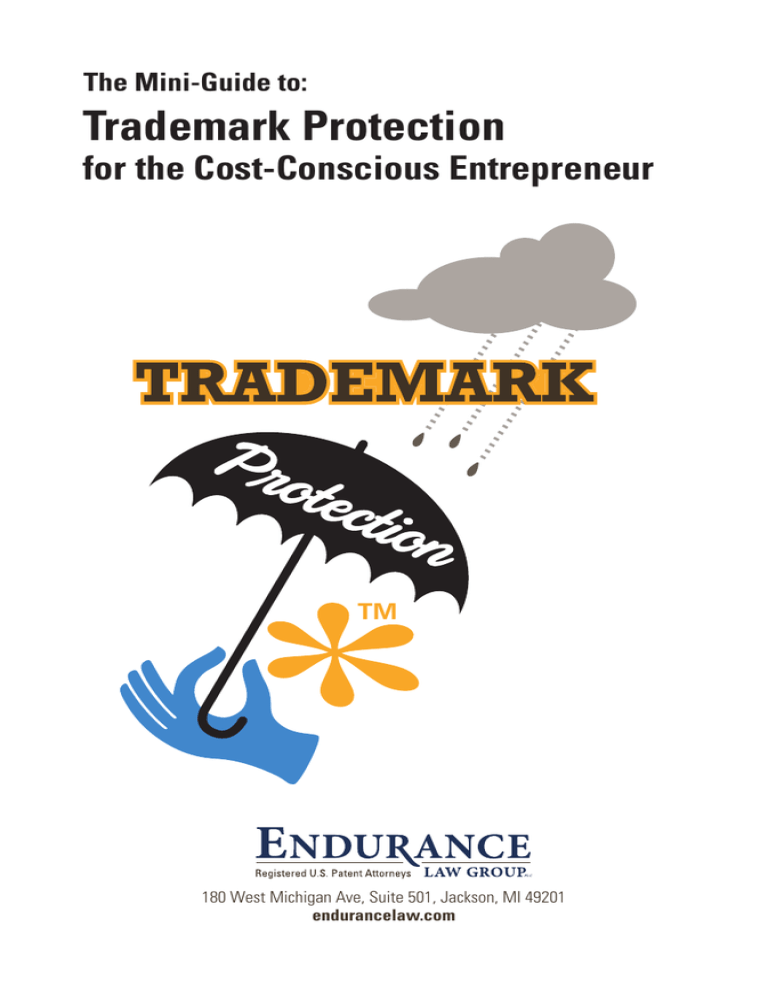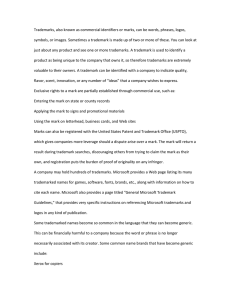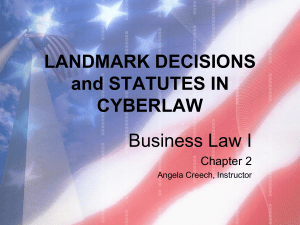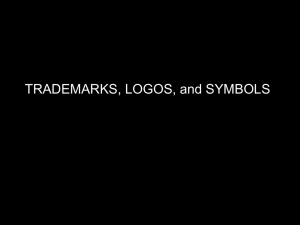
The Mini-Guide to:
Trademark Protection
for the Cost-Conscious Entrepreneur
TM
180 West Michigan Ave, Suite 501, Jackson, MI 49201
endurancelaw.com
The Mini-Guide to:
Trademark Protection for the
Cost-Conscious Entrepreneur
For entrepreneurs and many business people, choosing a name for a new product
or service is almost as much fun a choosing a name for a new baby. However, one
must not allow the enjoyment to lessen the caution that should always be exercised when choosing a new product or service name. And this admonition should
extend not only to names for products and services (i.e.,“brands”), but similar
attentiveness should also be used for the selection of names, tag lines, logos and
any other symbol that you might choose to associate with your product or service
or organization. Collectively, these names and brands and tag lines and symbols
are all variations of the form of intellectual property known as trademarks.
From a philosophical perspective, trademarks serve as a place-holder for all of
the good-will (and bad-will) that the populace possesses for an organization. For
example, if I showed you this famous logo chances are that the sight of that
image alone will reflexively cause you to summon all of your pent-up feelings
(good and bad) for the computer company Apple, Inc. Try another one:
. Or
how about this one:
. Your feelings beckoned at the sight of these icons
are your personal contribution to the collective “good will” that exists for the
respective organizations. These logos serve as symbolic receptacles for all the
good will that people behold for the organizations they represent.
The point is, trademarks can become exceptionally powerful tools and assets to
any organization. So it is important to make wise choices at the early stages of
a new business venture. It behooves the entrepreneur (as well as the marketing
director of any organization) to choose GOOD trademarks – strong receptacles of
good will – whenever possible.
Things to consider when adopting new trademarks:
There are “GOOD” trademarks and there are “BAD” ones. GOOD trademarks are
distinctive, and are not likely to create confusion in the marketplace. BAD trademarks threaten the existing trademark rights of others or for some other reason
inject confusion at the consumer/customer level. BAD trademarks are difficult
(or impossible) to protect. They may also put your organization at risk of adverse
legal action.
1
GOOD trademarks are distinctive. A distinctive trademark is not similar to any
word or phrase or symbol that is used by another organization that is active
in a related field of use. Furthermore, a distinctive trademark does not merely
describe features or qualities of the product or service with
which it is used. For example, HAMMER would not be a
distinctive a trademark for someone that
sells hammers. Likewise, SOFT would
not be a distinctive a trademark for a
company that sells pillows.
The best distinctive trademarks are made-up words/phrases
(like KODAK for a photographic film) or words/phrases that have nothing to do
with the product or service (like CAMEL for cigarettes). Slightly less distinctive
yet still good choices for trademarks are words/phrases that subtly suggest
something about the product/service or that convey a positive message about
some characteristic of your product/service. For example, CHAMPION for spark
plugs that make an engine perform like a winner or DOVE for a soap that is
gentle on the skin. Remember, trademarks that
merely describe a product/service are very
difficult --if not impossible-- to protect.
Risk Assess your proposed new trademark before using it:
In addition to selecting a distinctive name for your product or service (or business), the wise business person will research the existing trademark rights of
others in order to assess the risk that a newly adopted mark will infringe on the
rights of others. If it is discovered that one or more pre-existing trademarks pose
a high risk of conflict, the prudent person will find another brand name. After
all, what business person wants to encounter trademark turf battles at the same
time they are trying to launch a new product or start a new business?
In the United States, trademark rights derive from use of a distinctive mark in
commerce, not from registration. Did you get that? The first person to have actually used a distinctive trademark will usually trump a person that later registers
a trademark in the USA. So when two people want to use the same or similar
trademarks, it is always necessary to determine who first started using the trademark and the geographic reach of that use. The priority will often go to the first
person that actually used a distinctive trademark in commerce. (There are some
2
exceptions, such as when the second user had previously filed an “intent to use”
trademark application in the US Trademark Office.)
I wish I had a dollar for every time a person has told me they did not need to
conduct clearance research because “it’s our company name – we registered
it with the state.” Unfortunately, this is a common misconception. Registering
a corporate name or DBA with your state business bureau offers no assurance
whatsoever that use of that name in commerce will not provoke an infringement
threat. Another comment I often hear is “Our branding consultant told us there
was no problem.” It is unrealistic to expect that a marketing/branding consultant
will know the intricacies of the law well enough to render a reliable trademark
clearance opinion. If you expect your brand to be successful, seek out the advice
of a qualified trademark attorney before you commit to a new brand name.
Step 1: Self Help.
A common initial step to clearance research is for you (or someone affiliated with
your organization) to first do some detective work using on-line resources. Use
your favorite search engines to amass a list of all known trademarks in your market and selling regions that are similar in any possible respect (in appearance,
sound and connotation) to the trademark you want to adopt. Look carefully at
the existing product names on your list. For example, if your proposed trademark
is “Mountain,” existing trademarks like Mount Inn, Fountain, and Hill would all
be considered potentially relevant. For each mark on
your list, ask yourself “Might an average consumer
become confused between the existing trademark
and the one you would like to adopt?” Even identical
trademarks can coexist in the marketplace if the
underlying goods/services travel in different channels
of commerce. But an infringement risk can exist if the
goods/services are merely “related.” For example, a vitamin product named RED
BULL might be at risk from the energy drink maker because vitamins and energy
drinks could be considered “related” as nutritional items.
If the trademark you want to adopt is too close to an existing trademark in a
related field of use, then the average consumer has the potential to be confused
thinking the products are related in some way. A primary objective of U.S. trademark law is to reduce the chances that an average consumer will be confused
in their buying choices. If the brand/tag line/logo you want to adopt is similar
in look or sound or connotation to another organization’s trademark in a related
field, the average consumer could be confused. Determining whether fields are
related can be difficult sometimes. Are ice skates and basketballs related? May3
be… one could argue they are related fields as both can be found in the average
sporting goods store.
When evaluating the trademarks you find in your research, be honest with
yourself. Self-deception at this stage could cost you money and aggravation in
the future. Perhaps ask a friend to give an objective, unbiased opinion for any
potential conflicts you are not sure about. Do not allow yourself to downgrade
any potential red flag simply because you have grown emotionally attached to a
trademark that you would like to adopt. When in doubt, pick another trademark;
you always have an infinite number of alternative choices. Once you are satisfied
that your proposed new trademark is not too close to any existing trademarks in
your market and selling regions, move on to Step 2.
Step 2: Get Professional Help.
Any naming project – whether for a company name, a brand name, a logo, or
a product identifier – should include a comprehensive clearance search and
risk analysis by a competent trademark attorney. Although you may have
already thoroughly searched the internet and concluded that your proposed
new trademark is a good, safe choice (Step 1), the prudent business person will
engage a qualified trademark attorney to verify that the legal landscape is indeed
favorable. To be frank, it is unrealistic to expect that any average internet search
can tease out all the look-alikes, sound-alikes, and other permutations necessary
to make a proper clearance search. The professionals at Endurance Law Group
are experts in trademark research and trademark registration.
Depending on the situation, we may recommend starting with a medium level
(i.e., thorough but not exhaustive) search of federal and state databases. This
type of search is sometimes referred to as a basic “availability search.” The
average cost for an availability search in 2014 is about $750.
An even more thorough, comprehensive search of US federal and state databases combined with research for unregistered (i.e., common law) trademarks should
be completed before it is too late to pursue alternatives in the event your candidate trademark turns out to be a high-risk choice. The comprehensive trademark
search costs about $1500 in 2014.
Step 3: Register Your Trademark… Maybe.
Only after the research is complete, and your proposed trademark is deemed
“available for use,” should you think about filing an application to register the
trademark. Filing a trademark application is best left to the professional trade4
mark attorney. The average total cost to register a trademark in the U.S. is about
$2000-2500 in 2014 (assuming registration in only 1 class is needed and no third
party opposition is raised). The process of examination and registration takes, on
average, 9-12 months to complete.
Trademark registration provides several important (but not essential) advantages.
These include: statutory presumptions of validity and incontestability, presumed
nationwide constructive use of the trademark; the ability to seize imported goods
bearing the registered mark, and the availability of many civil and criminal counterfeiting provisions. However, we do not always recommend registration for all
trademarks. Indeed, there are times when not applying to register a trademark is
the more sensible choice. Conversely, there are time when a preemptive “intent
to use” trademark application is recommended. Every situation is different, and
that is why it is prudent to work with professional trademark attorneys in matters
as important to your business as its identity in the marketplace.
A word about policing your trademarks:
Thomas Jefferson is often attributed with originating
the phrase “The price of liberty is eternal vigilance.”
If I may adapt, “The price of a trademark is also
eternal vigilance.” Or perhaps in a more common
vernacular “You snooze; you lose.”
Trademark owners should diligently protect their trademarks from infringement
and other misuses that could harm its reputation. While a trademark owner does
not have a legal duty to find and remediate all possible trademark transgressions,
a complete failure to enforce one’s trademark will lead to weakened trademark
rights, loss of distinctiveness and potentially the complete inability to enforce the
trademark against all infringements.
Companies should ask their employees, customers and service providers to look
out for and report any potential infringements that may come to their attention.
A watch service can be engaged for a relatively moderate fee, perhaps $400500/year, that will actively monitor new trademark applications in the USA –
a good idea for important brands.
5
When potential infringements are identified, a discreet investigation should be
made to evaluate the situation. It is generally wise to check out the facts before
making any overt accusations. An over-anxious trademark owner that reflexively
fires the first shot across the bow of a would-be infringer could discover that the
“infringer” actually has a superior claim on the trademark who then assumes the
aggressor role.
If the discreet investigation determines that a response is warranted, you (the
trademark owner) should consider your business objectives and select a course of
action that will be most likely to achieve your desired outcome – be it monetary
damages, injunctive relief, a trademark license, a coexistence agreement, or
otherwise. Low level infringers may not seem cost-effective to pursue, but
nevertheless can do real harm to your trademark rights if ignored indefinitely. At
the very least, you should monitor low-level infringers and prepare to vigorously
enforce your trademark rights if the infringement expands or continues too long.
Over time, a trademark can become many times more valuable than any other
type of intellectual property your organization owns. Exercise care and prudence
when selecting new trademarks, so that you will be in a position to reap the
dividends for a long, long time to come.
ABOUT THE AUTHOR
Jon E. Shackelford is a registered U.S. Patent Attorney with more than 25 years’
experience in trademarks and other forms of intellectual property.
Contact Jon at 517.879.0241 or
jshack@endurancelaw.com.
© 2009, 2014 Jon E. Shackelford. All rights reserved.
Jon E. Shackelford
Note: This “Mini” Guide is provided for educational
purposes only, and must not to be considered legal advice.
The Apple logo, McDonald’s logo, Olympic symbol, Champion Bow Tie, Kodak logo, Dove
logo and Red Bull logo are trademarks of their respective owners. These trademarks
are “fair used” for educational purposes only and are not meant to imply any affiliation,
endorsement or sponsorship with the author or Endurance Law Group PLC.
6
An IP Haiku:
Those eager to own
Their inventions, brands and art
Need Endurance Law.
180 West Michigan Ave, Suite 501, Jackson, MI 49201
endurancelaw.com





